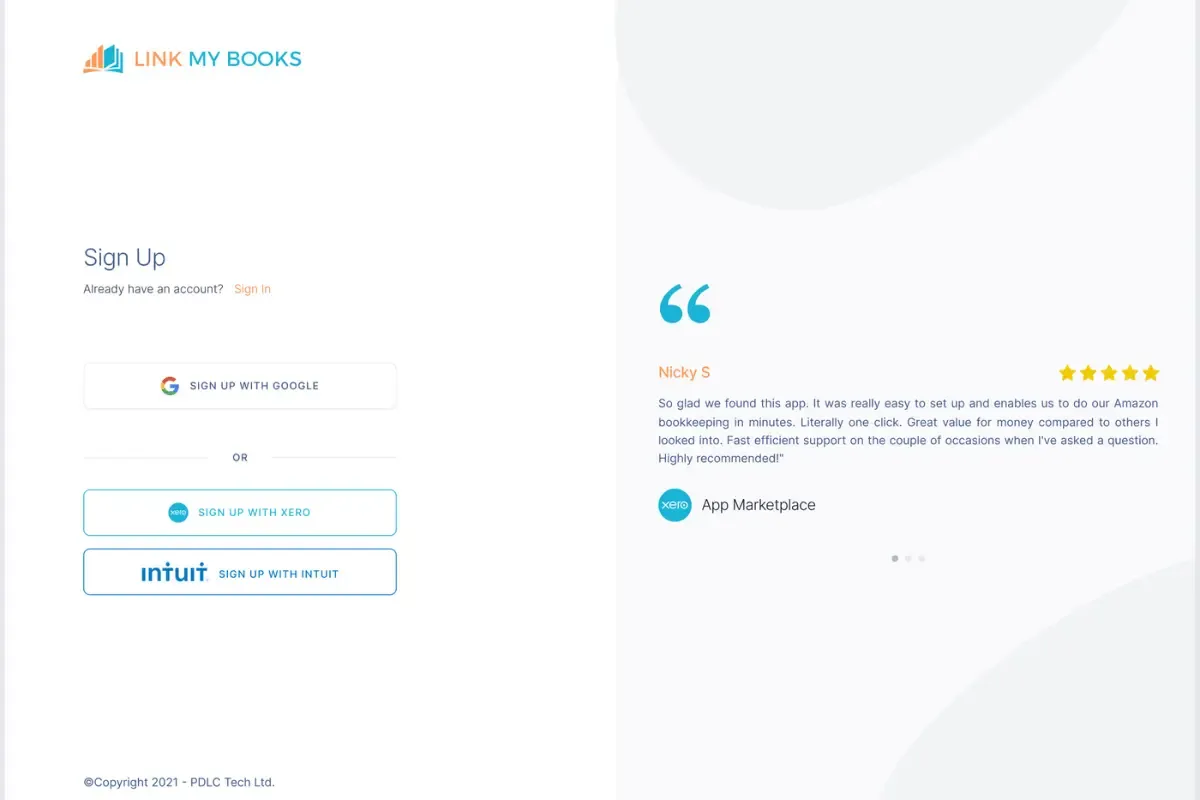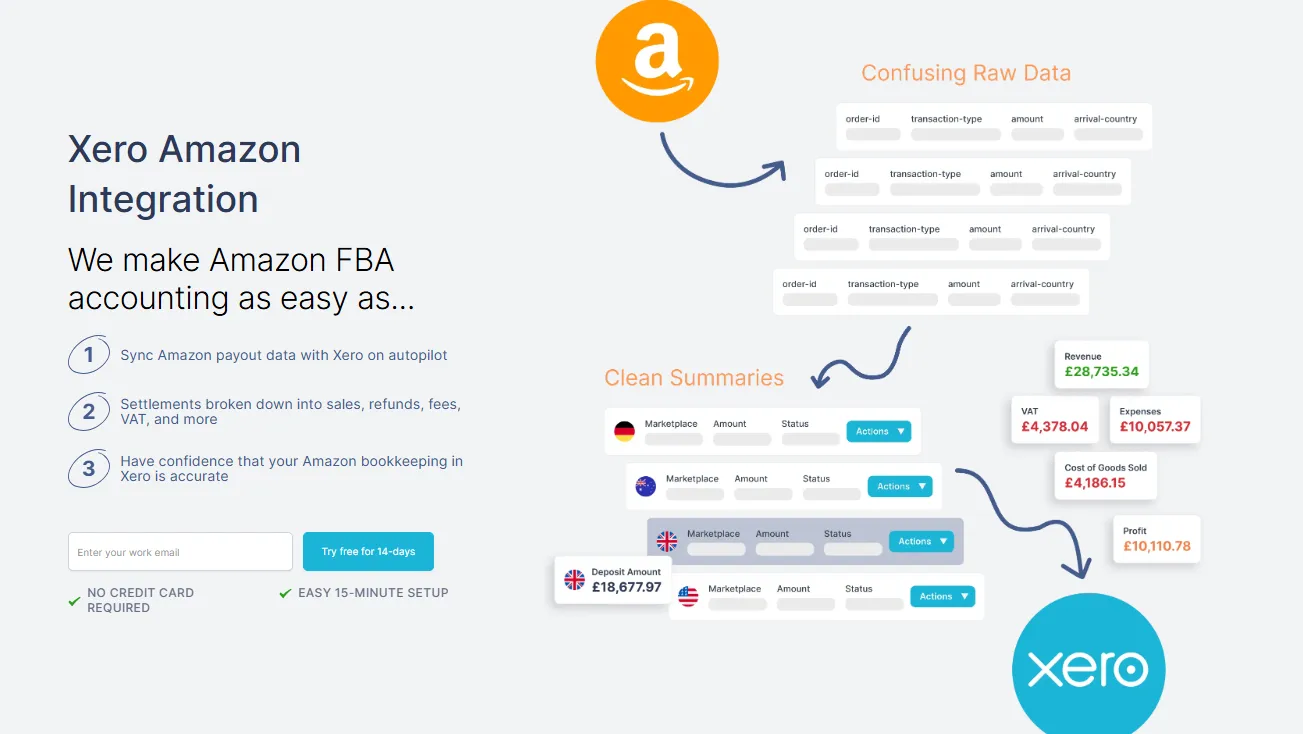If you’ve ever checked your Amazon Seller Central payouts and noticed that not all your money is there, this is why. The Account Level Reserve is Amazon’s way of protecting against refunds, chargebacks, and claims by holding back a portion of your sales. For sellers managing tight cash flow, this delay in accessing funds can create real problems.
In this guide, we’ll break down how the Amazon reserve system works, what triggers it, how much they can hold, and how to plan around it, especially if you’re VAT registered or need consistent payout data for bookkeeping.
Key Takeaways from this Post
Amazon’s Account Level Reserve holds back a portion of your sales, anywhere from 14 to 90 days, to protect against refunds and disputes.
The exact amount depends on your account health, return rate, and order volume, which can impact cash flow and delay reinvestment.
Tools like Link My Books help you stay ahead by automating payout tracking, flagging reserve amounts, and keeping your bookkeeping accurate, even when cash is held.







What is Account Level Reserve in Amazon?
So, what exactly is this Account Level Reserve? Picture this: You make some sales, and instead of getting all your money upfront, Amazon holds back a chunk. Why? It's like a safety net, ensuring that if something goes sideways, they have a buffer.
How Does an Account Level Reserve Work?
Think of the Account Level Reserve as a piggy bank that Amazon manages. They calculate a specific amount based on your sales and keep it aside. Don't worry; it's not forever. It's just their way of ensuring everything runs smoothly.
How does Amazon calculate the Account Level Reserve amount?
Amazon's got a formula for this. They consider your sales volume, returns, chargebacks, and other factors. Think of it as a behind-the-scenes financial health check, where Amazon crunches the numbers to safeguard both the buyer and seller experience.
Amazon's formula for calculating the reserve might seem complicated, but with Link My Books, the guesswork is taken out. The tool accurately tracks your sales, returns, and chargebacks, automatically applying the correct tax rates per country, which is essential for international sellers.

How Link My Books Simplifies Account Level Reserve for Amazon
Amazon doesn’t make it easy to track what’s held in reserve, what’s been released, and what’s actually hitting your bank. That’s where Link My Books steps in.
Instead of digging through payout reports or guessing how much Amazon is holding back, Link My Books gives you a clear breakdown of every settlement. Each entry is posted into Xero or QuickBooks with 100% accuracy, including the reserve amount.
This means no more reconciling missing funds manually or losing track of what Amazon is keeping on hold. You’ll always know where your money is, how long it’s held, and how it fits into your cash flow.
Here’s what to expect:
Automated Payout Breakdown

Link My Books automatically splits each Amazon payout into clear categories: sales, fees, refunds, and reserve amounts. No more digging through spreadsheets, everything is itemized and accurate, ready for reconciliation and review.
Reserve Amount Visibility

You’ll see exactly how much Amazon is holding in reserve for each payout and when those funds are expected to be released. This helps you monitor withheld earnings and plan around delays in cash availability.
Seamless Xero and QuickBooks Sync

Every part of your Amazon settlement, including the Account Level Reserve, is posted directly into Xero or QuickBooks. Your books stay clean, consistent, and up to date without lifting a finger.
Accurate Reconciliation

Because Link My Books tracks reserve amounts separately from what’s actually paid out, your bank feed matches perfectly every time. This avoids mismatches, confusion, and end-of-month headaches.
Cash Flow Forecasting
Knowing what’s held versus what’s paid helps you manage your working capital. Link My Books gives you visibility over your true available cash, so you can plan inventory, ad spend, and supplier payments with confidence.
Multi-Currency Support
If you sell in multiple regions, reserve amounts may be held in different currencies. Link My Books handles conversions automatically, ensuring accurate financial records no matter where you sell.
Link My Books gives you full visibility into your reserve amounts, automates your payouts, and keeps your books accurate.
🚀Start your free 14-day trial today and simplify your Amazon accounting.

How long does Amazon hold funds in reserve?
Patience is key here. Typically, Amazon holds these funds for 14 to 90 days, depending on your account's risk profile and history. This period allows Amazon to manage any issues that may arise from transactions. It's their way of covering any unexpected hiccups in transactions.
How long does Amazon take to process payment?
Once your funds are released from the reserve, Amazon processes payments within 3 to 5 days. This timeline ensures that all necessary checks are completed before you receive your earnings.
Why is my Amazon account level reserve so high?
The amount in your Amazon Account Level Reserve is influenced by several factors. A significant increase in sales, while beneficial, can lead to higher reserves as Amazon may anticipate potential fulfillment or customer service issues.
An increase in returns or chargebacks suggests possible problems with product quality or transaction disputes, prompting Amazon to adjust the reserve accordingly. Essentially, your reserve reflects your recent selling activity and is Amazon's way of managing risk.
Can your account level reserve in Amazon be negative?
In rare cases, Amazon sellers might experience a negative account balance. This situation arises when many items paid for in a previous month are returned or refunded in the current month. If the cost of these returns exceeds your current month's commission income, it leads to a negative balance.
Amazon manages this by deducting the negative amount from your future commission income. This approach is taken rather than requiring you to send in money, simplifying the process for sellers.
As a result, while your account balance may temporarily appear negative due to returns and refunds, it doesn't mean Amazon owes you money. It's a temporary accounting state, automatically rectified in the next payment cycle.

Reasons for Having an Account Level Reserve
Amazon's Account Level Reserve is a critical tool in its risk management strategy, aiming to balance seller freedom with customer protection. Understanding the reasons behind this reserve helps sellers navigate and potentially minimize its impact.
Risk Factors Leading to a Reserve
Let's explore the main risk factors that can cause Amazon to increase your Account Level Reserve.
High Return Rates
A key factor for Amazon is the rate of returns on your products. An unusually high return rate signals potential issues with product quality or customer satisfaction, prompting Amazon to implement a reserve as a precaution.
Customer Complaints
The frequency and nature of customer complaints are closely monitored. Frequent complaints, especially about product authenticity, shipping times, or product condition, can lead to a higher reserve.
Chargeback Rates
The rate at which customers initiate chargebacks, claiming they didn't receive the product or it wasn't as described, is a significant risk indicator for Amazon.
Account Health Metrics
Amazon also looks at your overall Amazon account health, including compliance with their policies and the health of your seller metrics. Any red flags here can lead to increased reserves.
Common Triggers for Account Level Reserve

Here are some common triggers that can lead Amazon to adjust your Account Level Reserve, ranging from sales volume changes to policy shifts.
Sales Volume Spikes
A sudden and significant increase in sales, while generally positive, can trigger a reserve. Amazon views this as a potential risk due to the increased volume of transactions to monitor.
Category Changes
Shifting to new product categories, especially those with higher fraud rates or return risks, can prompt Amazon to adjust your reserve.
Seasonal Variations
During peak seasons like holidays, when sales volumes surge, Amazon may adjust reserves to account for the heightened transactional activity.
Policy Changes
Sometimes, changes in Amazon’s policies or market conditions can also trigger adjustments in reserve levels.
Wait a Minute - Interested in Other Amazon Guides?
- Best Accounting Software for Amazon Sellers
- The Ultimate Guide on Amazon 1099-K Documents
- How to Use The Amazon Seller App
- Amazon 1P vs. 3P
- Amazon Fees
Factors Influencing Reserve Amount Variations

Various factors can cause fluctuations in your Amazon Account Level Reserve, from your seller performance to the types of products you sell. Let's delve into these elements to understand how they impact the reserve amount.
Seller Performance
Consistently positive performance, including low return rates and high customer satisfaction, can lead to a reduction in your reserve amount. Amazon rewards reliability and quality service.
Historical Sales Data
Your sales history plays a role. A long, stable history with Amazon can lead to a lower reserve as it demonstrates consistency and reliability.
Product Type
Certain products are deemed riskier than others. High-value items or electronics, known for higher return rates, might lead to a higher reserve.
External Factors
Occasionally, external factors like economic trends or changes in consumer behavior can impact reserve levels as Amazon adjusts to the broader market environment.
What Are The 3 Tiers in Account Level Reserve on Amazon?

Exploring Amazon's Account Level Reserve isn't complete without understanding its three-tier system and how each level impacts your selling journey. So let’s dive right in:
Tier I: Definition and criteria
When you first start selling on Amazon, you begin at Tier I.
This level is stringent, as Amazon withholds all of your sales revenue from the previous week for seven days following the processing of each payment.
Furthermore, any funds associated with unresolved transaction disputes, such as guarantee claims and chargebacks, are also retained.
This initial tier is Amazon's way of ensuring a secure environment for transactions with new sellers, providing a comprehensive safety net to address any early-stage concerns.
Tier II: Definition and criteria
Tier II is the next level up, typically reached after a seller completes a year on the platform.
However, there's a shortcut: if you manage to fulfill at least 100 orders while keeping your Order Defect Rate (ODR) below 1%, you can move up to this tier more quickly. The ODR is pivotal in determining your reserve status and directly influences your cash flow.
In this tier, the reserve conditions are more lenient. Depending on which is higher, Amazon will reserve either the total sum of unresolved transactions or 3% of your daily processed payments from the last four weeks. This tier strikes a balance, offering more flexibility to sellers with consistent performance and reliability.
Tier II Plus: Definition and criteria
Attaining Tier II-Plus is a significant achievement for Amazon sellers.
You can reach this tier two months after advancing to Tier II, provided you continuously maintain an ODR below 1% for 60 days. At this level, the reserve is confined solely to funds involved in unresolved transaction disputes.
This substantial reduction in reserve requirements greatly enhances your cash flow.
However, staying in Tier II-Plus demands ongoing vigilance.
If your ODR climbs above 1% at any point, your account will be downgraded back to Tier II. Amazon doesn't send out notifications for such changes, so you must regularly monitor your ODR through Amazon Seller Central to ensure you meet the criteria and retain your tier status.
Impact of Account Level Reserve on Amazon Sellers
The Account Level Reserve can significantly influence the financial dynamics of your Amazon selling experience. It's a key factor in determining the timing and amount of your payments, impacting everything from cash flow to business growth strategies.
How do Amazon sellers get paid?
As an Amazon seller, your payments are tied to your sales minus the Account Level Reserve. Once Amazon releases your funds from the reserve, they're directly deposited into your bank account. It's straightforward but subject to the reserve rules.
Amazon seller payment schedule
Amazon typically operates on a 14-day payment cycle. As a seller, you can expect Amazon payouts every two weeks. However, this depends on your Account Level Reserve status during each cycle.
When does Amazon pay you for selling?
Payments are made post the reserve period. Once Amazon is satisfied that your sales are legitimate and there are no outstanding disputes, they'll process your payment. It's all about ensuring a smooth transaction process.
How often does Amazon pay sellers?
Amazon pays sellers bi-weekly. This regular schedule helps you plan your finances, but remember, the actual amount you receive is after the reserve amount is deducted.
Limitations faced by sellers with a reserve
Having funds in reserve can put a squeeze on your operations. It can delay your ability to reinvest in inventory, limit your marketing efforts, and, overall, slow down your business growth. Managing your operations with the reserve in mind is a balancing act.
Effects on cash flow and operational capabilities
The biggest challenge of the reserve is its impact on cash flow. Limited access to your funds can affect how you manage inventory, handle supplier payments, and even your capacity to take advantage of growth opportunities. It's about being strategic with your available resources.
Account Level Reserve Release Process
Understanding the Account Level Reserve release process is crucial for Amazon sellers, as it directly affects how and when your funds become available. Here's an overview of how this process works, including strategies for releasing funds and the benefits of Amazon's ACH Same Day system.
Why is Amazon holding my funds for 90 days?
In some cases, Amazon extends the reserve period to 90 days, especially for accounts they deem high-risk. This could be due to a history of disputes, a sudden spike in sales, or other factors that raise Amazon's proverbial eyebrows.
How to get Amazon to release funds
Maintaining a healthy account is vital to getting Amazon to release funds sooner. This means keeping your Order Defect Rate low, resolving customer issues promptly, and ensuring your transactions are transparent and dispute-free. A clean track record can lead to quicker fund releases.
What is ACH Same Day in Amazon?
ACH Same Day is Amazon's faster payment processing system. It allows for same-day fund transfers once they are released from the reserve. This can be a game-changer for managing your cash flow more effectively.
Tips for achieving a reserve-free account status on Amazon
Unlocking a reserve-free status on Amazon might seem like a tall order, but with these strategic tips, you're well on your way to achieving just that.
Maintain Excellent Performance
Keep your customer satisfaction high and return rates low. A strong track record on these fronts signals to Amazon that you're a reliable seller, which can positively impact your reserve status.
Utilize Tools Like Link My Books
Incorporate tools like Link My Books to streamline your financial tracking and management. Link My Books seamlessly integrates with Xero and QuickBooks, offering an efficient way to handle your sales data from Amazon.
Integrating Link My Books into your financial management simplifies the bookkeeping process and offers clear insights into your financial status. Such visibility aids in making informed decisions, crucial for maintaining a healthy reserve level on Amazon.
Manage Your Account Health
Regularly check your Amazon Seller Central account for any flags or issues and address them promptly.
Diversify Your Offerings
Selling a range of products can mitigate the risks associated with high-reserve categories.
Stay informed, keep abreast of any changes in Amazon’s policies, and adjust your strategy accordingly.
Engage with Customers
Positive customer interactions can lead to better feedback, impacting your reserve status favorably.
Take Control of Amazon Reserves With Link My Books

Managing Amazon’s Account Level Reserve doesn’t have to be a mystery. Link My Books gives you instant clarity, automating payout breakdowns, tracking held funds, and syncing everything to Xero or QuickBooks without the manual grind.
Start your free 14-day trial today and get the visibility and control your business needs to scale with confidence.



















.png)